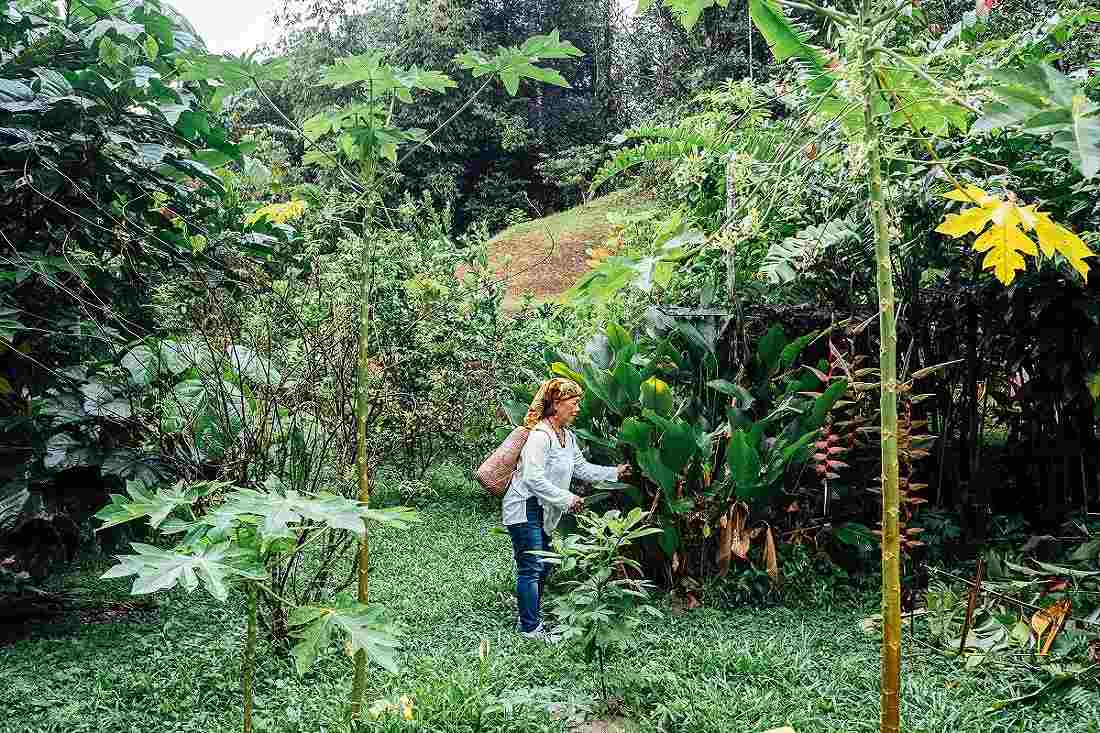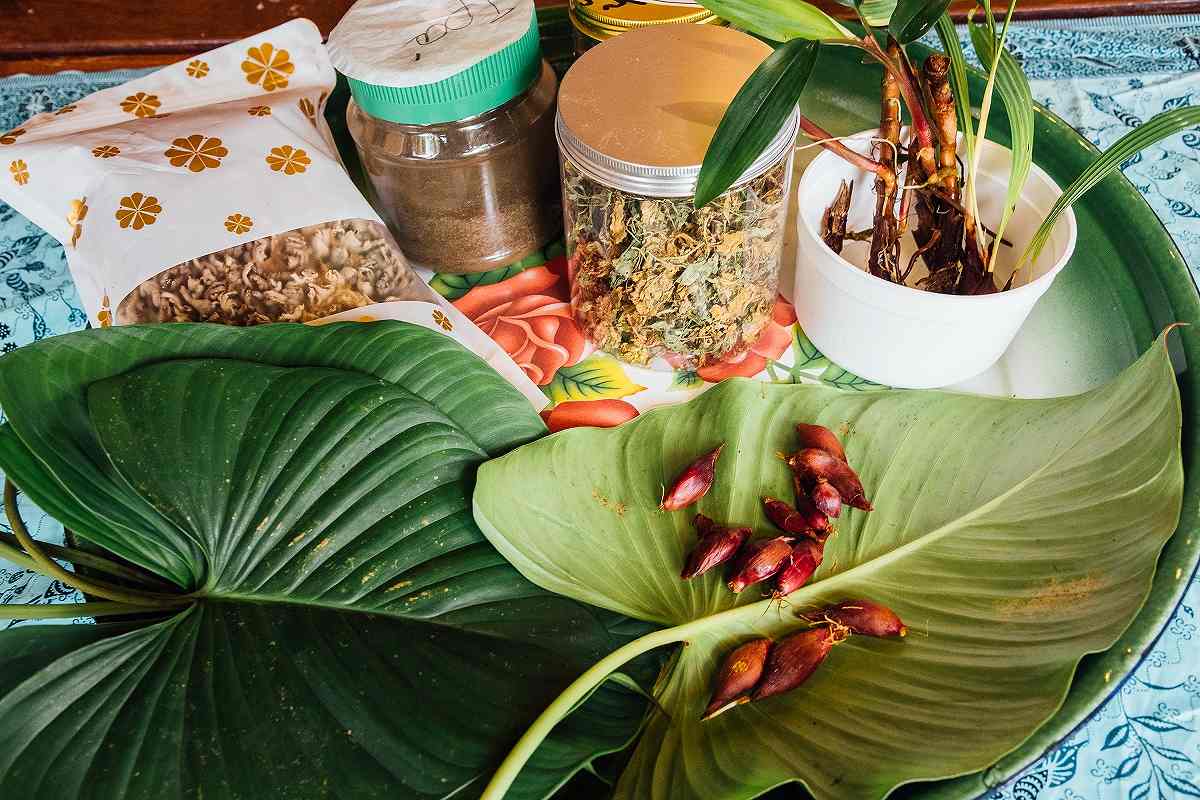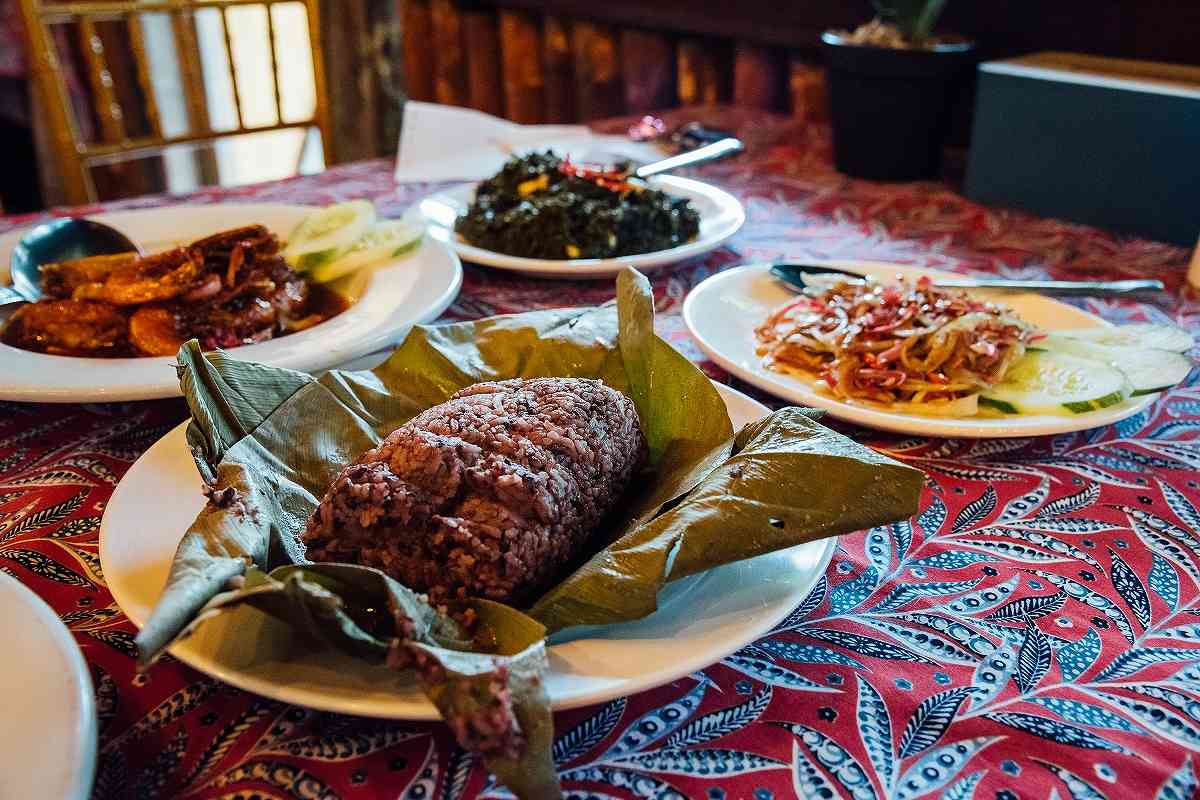
Mina Trang-Witte, 65, a home cook from the Kelabit tribe in Malaysia’s Sarawak state, has received a growing number of guests eager to learn what she knows about cooking with jungle produce.
16:28 JST, March 23, 2024
KUCHING, Malaysia – The lush jungles of Borneo have always been exciting pantries for those able to recognize what can be eaten and how to prepare it. Indigenous people used to rely solely on these jungles, among the most biodiverse ecosystems in the world, to sustain themselves. But as modernity spread across the island in the past two centuries, tribal elders worried that many of their Indigenous culinary practices would die out.
Now, to their relief, a renaissance of Borneo’s traditional food culture is underway.
Confronted by the climate crisis and disruptions to global supply chains, people across the world have been searching for more sustainable and localized sources of food, driving a resurgence of Indigenous food practices. In few other places has the revival been as dramatic as in the Malaysian state of Sarawak on the northwestern coast of Borneo, where about 40 percent of the population of 2.5 million has Indigenous heritage.
Malaysian chefs who left for fine-dining restaurants abroad are returning to set up shop in Sarawak, venturing into the forests to forage for rare jungle produce such as the flowers of wild-growing durian trees, which bloom sometimes for less than a week. Families who inherited the fading practice of tapping sugar from mangrove palms have found new champions in environmental advocates.
An hour outside the state capital of Kuching, a petite woman from one of Sarawak’s hill-dwelling tribes, the Kelabit, receives a revolving door of guests – chefs, researchers, hobbyists – eager to learn what she knows about cooking with the plants and insects found only in Borneo’s rainforests.

Wild yam leaves, local gingers and other Indigenous plants collected from Trang-Witte’s garden outside Kuching. She has passed down only about 30 percent of what she knows about Indigenous cooking and cuisine to her children, she said.
The aromatic stems of wild ginger, called tepus; baskets of juicy sago worm, known as ulat mulong; and bunches of twirling jungle fern, or midin, found in Kuching’s wet markets barely scratch the surface, said Mina Trang-Witte, 65. Many plants she forages don’t have English translations; some don’t have names at all.
“I’m just a simple village cook,” she said, smiling coyly from her breezy house atop forested hills. “Now, suddenly, everybody wants to see me.”
While Indigenous food knowledge has been eroding for centuries in regions such as North America, it has faded “dramatically fast” over the span of one or two generations in developing countries in South America and Southeast Asia, environmental researchers say. Now this tide is turning: In countries that share the Amazon rainforest, Indigenous chefs are finding new popularity. Last year, four restaurants in Lima, Peru, made it onto the World’s 50 Best Restaurants – a credit, chefs said, to their Indigenous suppliers in the Amazon.
In Sarawak, Indigenous food culture received its biggest boost in 2021, when the United Nations’ cultural protection agency, UNESCO, named Kuching one of its several dozen “cities of gastronomy,” citing the combination of its biodiversity and Indigenous heritage. Since then, heritage food festivals and events have sprouted in the city. A new gastronomy center is under construction. And late last year, Antoni Porowski, the food and wine guy on the TV show “Queer Eye,” visited to film part of a new National Geographic docuseries, “No Taste Like Home.”
The rising profiles of dishes like asam siok – marinated chicken wood-fired in bamboo stems – and nuba laya – mashed rice from the Bario highlands steamed in leaves – mark a stark change from as recently as a decade ago, when stories being told of Indigenous culture in Sarawak were mostly ones of loss, said Karen Shepherd, a Kuching-based writer serving as the focal point for the UNESCO designation. “We’re in a stage now of not just revival but of massive experimentation,” she said. “There’s a real sense of the uniqueness of being [Indigenous] in a global context.”
More young Sarawakians – some with Indigenous heritage, some without – are learning native methods of foraging, smoking and fermenting. Many are also offering their own interpretations of these practices and finding ways to commercialize them, giving rise to new, sometimes tense debate over the future of Indigenous culture.
In conversations with The Washington Post, more than a dozen chefs, brewers, restaurateurs and tribal elders said they believe what Sarawakians want is not to restore Indigenous ways of life but to incorporate aspects of it in addressing contemporary challenges, from underinvestment in East Malaysia, where Sarawak is located, to the climate crisis.
In 2021, marooned at home during the pandemic, four Sarawakian millennials of different ethnic backgrounds met on Zoom to talk about how much they loved the food of their home state. They launched the Sarawak Gastronomy Incubator program and, last year, organized the first festival for tuak, an Indigenous rice wine traditionally brewed at home by women for friends and family.
Enthusiasm for the three-day festival, pulled together in a few weeks, exceeded expectations, organizers said. Thousands of attendees sampled and bought tuak made by aging matriarchs coaxed out of wooden longhouses in remote villages, many of whom had never sold their tuak commercially before.
One of the longest lines was at the stall of Annie Tapak, 70, who had been making tuak – or what her ethnic Bisaya tribe calls pangasi – for three decades, spending long afternoons on her own with a large vat she kept under drying lines of laundry. When she was awarded two top prizes at the festival for her clear, refined brew, she bloomed bright red and froze before she was ushered onto a stage, relatives recalled.
Under the influence of Christianity and Islam, which forbids alcohol, brewing culture among the Bisaya tribe came close to disappearing in the 1980s, said Peter Sawal, a tribal elder. No longer. “The pride,” said Sawal, 66, “has come back.”
While pandemic lockdowns slowed many businesses to a halt, they were “a blessing” in that they forcibly drew young Sarawakians home, where they had more opportunities to explore their heritage, said Dona Drury Wee, chair of the Culinary Heritage and Arts Society Sarawak. “Everyone suddenly wanted to have some form of deeper connection to their identity as a Sarawakian,” said Ehon Chan, 38, managing director of the gastronomy incubator.
A young Bidayuh woman, fresh out of college, started a tuak business with her grandmother. A biotechnology professor, frustrated with a lack of funding for his research, started learning how to brew tuak from YouTube videos.
More home brewers are popping up, and plans for a bigger tuak festival in 2024 are underway. But the greater test, said Chan, is how long momentum can be maintained. Unless tuak brewers and other businesses built around Indigenous cuisine are able to reach a mainstream audience, they could be seen as “faddish,” said Chan.
In 2017, John Lim, a native of the capital, Kuala Lumpur, who is married to a Sarawakian, opened a restaurant in Kuching serving high-end European cuisine and using 80 percent locally foraged ingredients and Indigenous cooking methods. While the restaurant, Roots by Food Journal, has drawn acclaim for its creativity, it’s a “break-even restaurant,” said Lim, 36.
Even now, it is challenging to pitch higher prices for items such as brioche made with the buttery nuts of the local engkabang tree or oysters topped with a reduction made from jungle star fruit. It’s unconventional, Lim conceded, and not what people are used to when they look for either European or Indigenous food.
Still, he has no intention of changing his approach, he said.
One recent afternoon, Lim entered his walk-in refrigerator and put his nose to one of his favorite ingredients – preserved wild garlic, or buah kulim, which gives off an oaky scent similar to that of truffles. He forages himself in the jungle every few weeks and thinks more chefs should come smell and taste Borneo’s bounty for themselves, he said.
“There’s too much here,” Lim added, “for just a few of us.”

"News Services" POPULAR ARTICLE
-

American Playwright Jeremy O. Harris Arrested in Japan on Alleged Drug Smuggling
-

Japan’s Nikkei Stock Average as JGB Yields, Yen Rise on Rate-Hike Bets
-

Japan’s Nikkei Stock Average Licks Wounds after Selloff Sparked by BOJ Hike Bets (UPDATE 1)
-

Japanese Bond Yields Zoom, Stocks Slide as Rate Hike Looms
-

Japan’s Nikkei Stock Average Buoyed by Stable Yen; SoftBank’s Slide Caps Gains (UPDATE 1)
JN ACCESS RANKING
-

Keidanren Chairman Yoshinobu Tsutsui Visits Kashiwazaki-Kariwa Nuclear Power Plant; Inspects New Emergency Safety System
-

Imports of Rare Earths from China Facing Delays, May Be Caused by Deterioration of Japan-China Relations
-

University of Tokyo Professor Discusses Japanese Economic Security in Interview Ahead of Forum
-

Japan Pulls out of Vietnam Nuclear Project, Complicating Hanoi’s Power Plans
-

Govt Aims to Expand NISA Program Lineup, Abolish Age Restriction



















